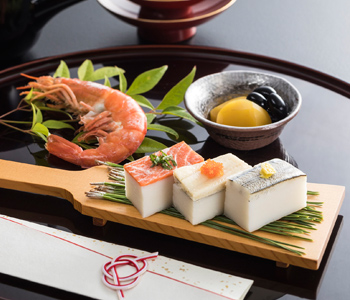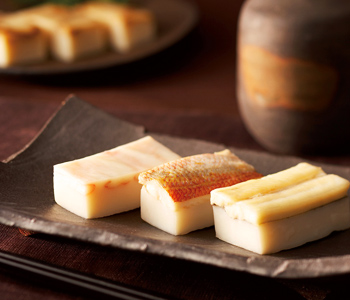- Top
- About Kawachiya
- History of Kawachiya
Uozu Station around 1963(courtesy of Uozu City)
Chapter 1
Launched business in Uozu
Soon after the end of World War II in 1947, Yukio Kawauchi, the founder of Kawachiya, began kamaboko production (processed seafood, where mainly white fish are pureed, formed into loaves, and steamed) at the Kawachiya Kamaboko Factory in Uozu, Toyama. In Toyama Prefecture at that time, there were many kamaboko producers because Toyama was blessed with plenty of fresh fish caught in Toyama Bay. Most of these producers ran community-based, home manufacturing businesses. In such an environment, Kawachiya began business as a relatively latecomer to the kamaboko market in Toyama.
At that time, kamaboko producers used to start making kamaboko at midnight, finish early in the morning or before noon at latest, and sell them wholesale to fish stores and fish markets. Since it was a time when anything you made would sell well as not so many products were available and products were not manufactured in large quantities, kamaboko producers used to carefully process fresh fish just out of the sea, make them into kamaboko, and sell them the same day they were made in the corner of a factory to local people. Since every process was done manually, there were many people working in factories, creating a vibrant atmosphere.
The raw materials used in kamaboko production were fish mostly caught in the sea around Toyama Bay, such as Pacific cod, Alaska pollock, barracuda, Argentine, mackerel, flying fish, and flounder. Since kamaboko produced in Toyama featured a stronger focus on fish taste than color, its water exposing process was shorter, and the color was slightly darker than other kamaboko products. With its rich fish flavor and taste, kamaboko from Toyama enjoyed a reputation as a high-quality, luxury item at that time.
Later, the transportation network including railways was developed across the country, which brought in ice-packed fresh fish into Toyama, a prefecture located substantially at the center of Japan, from all over the country: white croaker and pike eel from Kyushu in the west and Alaska pollock and arabesque greenling from Hokkaido in the east.
Our main store is conveniently located in front of JR Uozu Station, which provides easy access to both Uozu Port and the train station. We owe this convenient location to the wisdom of our founder who knew that fresh fish is indispensable for producing delicious kamaboko. To our founder, the natural environment of Uozu may have looked a precious treasure: located between the over 3,000-meter Tateyama mountain range and Toyama Bay with a maximum depth of over 1,000 meters, Uozu has few plains, but is blessed with plenty of water from melting snow.
In 1956 when a massive fire (Uozu Fire) broke out and burnt down more than 1,500 houses in Uozu, Kawachiya expected that its factory would also be burnt down. However, since the wind miraculously shifted right before the fire reached the factory, Kawachiya escaped damage. Kazuo, the oldest son (the second owner of the factory) who was a second-year junior high school student at that time, still vividly remembers the great deal of fear he felt when he saw the flames coming on the roof of the factory.
Later, Uozu was rapidly restored thanks to the dedicated efforts of many people. At the national athletic meet in Toyama in 1958, Emperor and Empress Showa watched the restored Uozu from the roof of the rebuilt Muraki Elementary School near Kawachiya.
Although Kawachiya had escaped damage from the historical massive fire of Uozu by a miracle, the residential part of its home and factory was burnt down in 1960 by a fire that broke out next door, and valuable materials and photos collected since its foundation were completely lost. Fortunately, however, the factory was only partly damaged, which enabled Kawachiya to continue kamaboko production.
While improving sanitation and production efficiency over time, we at Kawachiya still continue to produce handmade kamaboko in the original place and with the enduring foundation spirit.
Chapter 2
Birth of Sushikama
Around 1965, an innovative technology for frozen surimi (literally fish puree) was established in the Japanese fishing industry.
At that time, fish catches in the sea near Toyama Bay were declining, and together with new issues of this age brought by economic development, such as environmental problems, it was getting more difficult to obtain high quality raw materials on a stable basis. In such a social context, the new technology that enabled the efficient use of high quality Alaska pollock, which are abundant in the north sea, was good news to kamaboko producers as it eliminated their concern about raw materials. The technology rapidly spread among kamaboko producers not only in Toyama, but also across the country. The advanced technology to make fish puree also spread around the world and the term “surimi” is now commonly used around the world.
On the other hand, the emergence of frozen surimi not only opened a new era for mechanization-driven mass production, but also brought an adverse effect, that is, the disappearance of the unique local flavor.
Despite such a major environmental change, however, kamaboko producers in Toyama nurtured a distinctive kamaboko culture featuring kamaboko without a board. The local kamaboko products representing Toyama included “Kobumaki Kamaboko”, kamaboko wrapped in a sheet of high quality kelp brought into Toyama from Hokkaido since ancient times by Kitamaebune ship, and colorful “art kamaboko” in the shapes of sea bream, cranes, and tortoises.
However, the big current of the times toward mass production and mass consumption also affected Toyama, making kamaboko into a product that was sold in volume at low prices in supermarkets.
In such an era of mass production, where even the time-honored kamaboko of Toyama was rapidly popularized, Kazuo Kawauchi, the second owner of Kawachiya, focused on enhancing the added value of the traditional Toyama kamaboko and began developing kamaboko products unique to Kawachiya in an effort to clearly differentiate it from other kamaboko producers. When having an ordinary meal with his family, he came up with an idea of unique kamaboko, the original for the later established Sushikama, which marked the beginning of the new history of Kawachiya. Although Sushikama took the current form after much trial and error, it was not welcomed by the Toyama kamaboko industry, and there was not a single store that offered to sell it. Most people may have regarded Sushikama as a product that a latecomer created to make a display of being unusual. Despite the difficulty in opening a new local market, Kawachiya upheld the policy that “We sell the products we created on our own by ourselves,” and opened the Uozu main store, a store directly managed by Kawachiya in July 1982. At the same time, it strived to enhance customer satisfaction not only in Toyama, but also outside the prefecture by aggressively promoting delicious products produced in the Hokuriku region.
In February 1985, Kawachiya obtained a process patent, a utility model patent, and a trademark for Sushikama.
After obtaining these patents, it received many business inquiries from outside Toyama Prefecture, particularly from big department stores,and its Sushikama was introduced in many popular magazines, leading to a radical change in the public recognition of Sushikama. Rolled kamaboko and Sushikama
Around this time, many expressways were built and motorization accelerated, which had a great impact on Toyama’s economy and tourism. Consequently, the reputation “There is Sushikama at Kawachiya!” gradually spread across Toyama, Hokuriku, and the country, raising its visibility.
Today, there are many products similar to Sushikama, and kamaboko with sushi toppings are now collectively called Sushikama. Sushikama has finally acquired citizenship in Toyama. Kawachiya as a Sushikama store continues to actively transmit a new kamaboko culture mainly through its directly managed stores.



